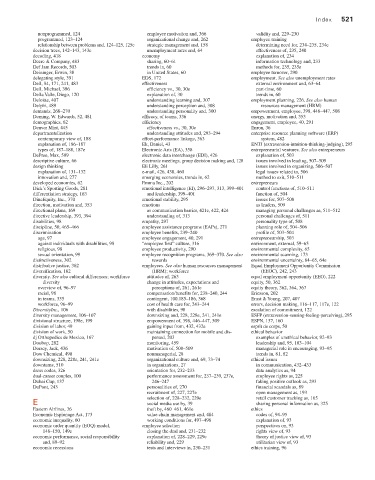Page 522 - Fundamentals of Management Myths Debunked (2017)_Flat
P. 522
nonprogrammed, 124 employee motivation and, 366 validity and, 229–230 Index 521
programmed, 123–124 organizational change and, 262 employee training
relationship between problems and, 124–125, 125e strategic management and, 158 determining need for, 234–235, 234e
decision trees, 142–143, 143e unemployment rates and, 64 effectiveness of, 235, 240
decoding, 418 economy explanation of, 234
Deere & Company, 483 sharing, 60–61 information technology and, 233
Def Jam Records, 503 trends in, 60 methods for, 235, 235e
Deininger, Erwin, 38 in United States, 60 employee turnover, 290
delegating style, 391 EDS, 172 employment. See also unemployment rates
Dell, 84, 171, 241, 483 effectiveness external environment and, 63–64
Dell, Michael, 396 efficiency vs., 30, 30e part-time, 60
Della Valle, Diego, 120 explanation of, 30 trends in, 60
Deloitte, 407 understanding learning and, 307 employment planning, 226. See also human
Delphi, 489 understanding perception and, 308 resources management (HRM)
demands, 268–270 understanding personality and, 300 empowerment, employee, 398, 446–447, 508
Deming, W. Edwards, 52, 481 efficacy, of teams, 336 energy, motivation and, 353
demographics, 62 efficiency engagement, employee, 40, 291
Denver Mint, 445 effectiveness vs., 30, 30e Enron, 36
departmentalization understanding attitudes and, 293–294 enterprise resource planning software (ERP)
contemporary view of, 188 effort-performance linkage, 363 system, 482
explanation of, 186–187 Ek, Daniel, 43 ENTJ (extraversion-intuition-thinking-judging), 295
types of, 187–188, 187e Electronic Arts (EA), 358 entrepreneurial ventures. See also entrepreneurs
DePree, Max, 509 electronic data interchange (EDI), 426 explanation of, 503
descriptive culture, 66 electronic meetings, group decision making and, 128 issues involved in leading, 507–509
design thinking Eli Lilly, 261 issues involved in organizing, 506–507
explanation of, 131–132 e-mail, 426, 438, 460 legal issues related to, 506
innovation and, 277 emerging economies, trends in, 62 method to exit, 510–511
developed economies, 62 Emma Inc., 202 entrepreneurs
Dick’s Sporting Goods, 281 emotional intelligence (EI), 296–297, 313, 399–401 control functions of, 510–511
differentiation strategy, 163 and leadership, 399–401 function of, 504
DineEquity, Inc., 370 emotional stability, 295 issues for, 507–508
direction, motivation and, 353 emotions as leaders, 509
directional plans, 169 as communication barrier, 421e, 422, 424 managing personal challenges as, 511–512
directive leadership, 393, 394 understanding of, 313 personal challenges of, 511
disabilities, 98 empathy, 297 personality type of, 508
discipline, 50, 465–466 employee assistance programs (EAPs), 271 planning role of, 504–506
discrimination employee benefits, 239–240 profile of, 503–504
age, 97 employee engagement, 40, 291 entrepreneurship, 503
against individuals with disabilities, 98 “employee first” culture, 316 environment, external, 59–65
religious, 98 employee productivity, 290 environmental complexity, 65
sexual orientation, 99 employee recognition programs, 369–370. See also environmental scanning, 173
distinctiveness, 302 rewards environmental uncertainty, 64–65, 64e
distributive justice, 362 employees. See also human resources management Equal Employment Opportunity Commission
diversification, 162 (HRM); workforce (EEOC), 242, 243
diversity. See also cultural differences; workforce attitudes of, 263 equal employment opportunity (EEO), 222
diversity change in attitudes, expectations and equity, 50, 362
overview of, 96–97 perceptions of, 261, 261e equity theory, 362, 364, 367
racial, 98 compensation/benefits for, 238–240, 244 Ericsson, 202
in teams, 335 contingent, 100.185–186, 368 Ernst & Young, 207, 407
workforce, 96–99 cost of health care for, 243–244 errors, decision making, 116–117, 117e, 122
DiversityInc., 106 with disabilities, 98 escalation of commitment, 122
diversity management, 106–107 downsizing and, 228, 228e, 241, 241e ESFP (extraversion-sensing-feeling-perceiving), 295
divisional structure, 198e, 199 empowerment of, 398, 446–447, 509 ESPN, 157, 160
division of labor, 49 gaining input from, 432, 432e esprit de corps, 50
division of work, 50 maintaining connection for mobile and dis- ethical behavior
dj Orthopedics de Mexico, 167 persed, 203 examples of unethical behavior, 92–93
Doobop, 282 monitoring, 459 leadership and, 95, 103–104
Dorsey, Jack, 436 motivation of, 508–509 managerial role in encouraging, 93–95
Dow Chemical, 490 nonmanagerial, 28 trends in, 81, 82
downsizing, 228, 228e, 241, 241e organizational culture and, 69, 73–74 ethical issues
downturns, 510 in organizations, 27 in communication, 432–433
dress codes, 326 orientation for, 232–233 data analytics as, 94
dual-career couples, 100 performance assessment for, 237–239, 237e, employee rights as, 225
Dubai Cup, 137 246–247 faking positive outlook as, 293
DuPont, 243 personalities of, 270 financial scandals as, 89
recruitment of, 227, 227e open management as, 193
E selection of, 228–232, 229e retail customer tracking as, 165
sharing personal information as, 325
social media use by, 39
Eastern Airlines, 36 theft by, 460–461, 461e ethics
Economic Espionage Act, 173 value chain management and, 484 codes of, 94–95
economic inequality, 60 working conditions for, 497–498 explanation of, 93
economic order quantity (EOQ) model, employee selection perspectives on, 93
148–150, 149e closing the deal and, 231–232 rights view of, 93
economic performance, social responsibility explanation of, 228–229, 229e theory of justice view of, 93
and, 89–92 reliability and, 229 utilitarian view of, 93
economic recessions tests and interviews in, 230–231 ethics training, 96

